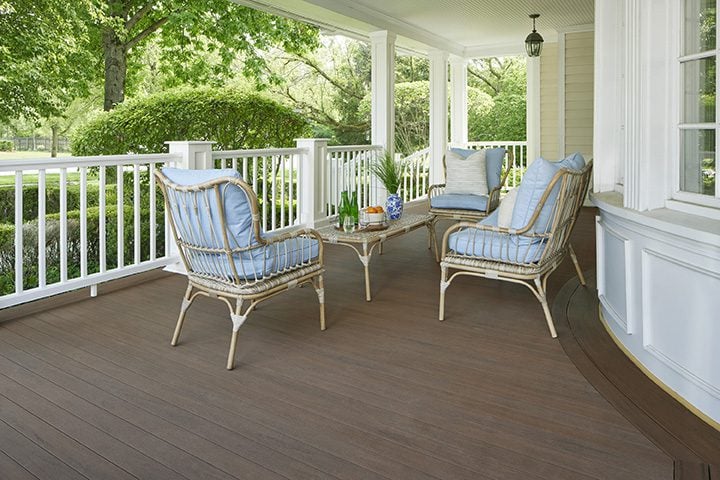Tongue and groove (T&G) deck boards are a timeless and functional choice for creating seamless and stylish outdoor surfaces. Featuring a system where one board’s “tongue” fits into the adjacent board’s “groove,” T&G decking provides a smooth, gap-free surface that is ideal for certain applications. However, selecting the right type of T&G deck board and understanding where to use it are critical for long-lasting results.
Common Types of Tongue and Groove Deck Boards
T&G boards are available in a wide range of materials, each offering unique benefits. Here are some of the most common types:
1. Pressure-Treated Pine

- Affordable and accessible, pressure-treated pine is a popular option for budget-conscious projects.
- Treated to resist decay and insect damage, it performs well in covered spaces. However, it requires regular maintenance to prevent warping or cracking.
2. Western Red Cedar

- Loved for its natural beauty and aromatic scent, Western Red Cedar is lightweight, durable, and naturally resistant to rot and insects.
- Its warm tones add a cozy aesthetic, making it a popular choice for porches and sunrooms.
3. Ipe

- Often referred to as “Brazilian Walnut,” Ipe is one of the most durable hardwoods available. It boasts exceptional resistance to rot, insects, and weathering.
- Known for its longevity and rich color, Ipe is a premium choice for T&G decking, especially in high-end projects.
4. Cumaru

- Similar to Ipe, Cumaru offers exceptional hardness and resistance to the elements at a slightly lower cost. Its golden to reddish-brown hues make it a stunning option for any space.
5. Tigerwood

- Tigerwood is a unique hardwood known for its distinctive striped grain patterns. It combines durability with striking aesthetics, making it a favorite for luxury projects.
6. Mahogany

- Mahogany offers a classic look with its rich, reddish-brown color. It is moderately durable and often used for covered porches and other protected areas.
7. Garapa

- Sometimes called “Brazilian Ash,” Garapa is a light-colored hardwood with excellent resistance to rot and insects. It is an affordable alternative to other tropical hardwoods.
8. Brazilian Redwood

- Known for its exceptional strength and longevity, Brazilian Redwood is an excellent option for T&G decking. Its deep red tones age beautifully over time.
9. PVC (Polyvinyl Chloride)

- PVC T&G boards are low-maintenance and highly weather-resistant. Unlike wood, they won’t rot, warp, or fade, making them ideal for homeowners seeking a long-lasting, hassle-free option.
Where Are Tongue and Groove Deck Boards Most Commonly Used?
T&G deck boards are most commonly used in covered outdoor areas, where their smooth, gap-free surface adds both aesthetic appeal and practical benefits. These spaces include:
- Porches
- Sunrooms
- Covered patios
- Gazebos
- Screened-in decks
The interlocking design of T&G boards prevents gaps and provides a polished, finished look, making it ideal for spaces where comfort and appearance are top priorities.
Why T&G Deck Boards Should Not Be Used on Open Decks
While T&G boards are a great choice for covered spaces, they are not suitable for open decks without a roof. Here’s why:
- Lack of Drainage
T&G boards create a tight, gap-free surface that cannot shed water effectively. In uncovered areas exposed to rain or snow, this can lead to standing water, which promotes rot and decay. - Moisture Trapping
Without proper ventilation, moisture can become trapped beneath the boards, leading to mold, mildew, and structural issues.
For open decks, it’s best to use decking materials with proper spacing to allow water to drain and airflow to keep the structure dry.
Choosing the Right Material for Your T&G Deck
When selecting T&G deck boards, consider the climate, the level of maintenance you’re willing to perform, and the aesthetic you want to achieve. Tropical hardwoods like Ipe and Cumaru offer unmatched durability and beauty, while options like Western Red Cedar and Mahogany provide classic charm. For low-maintenance solutions, PVC boards are a fantastic alternative.
Conclusion
Tongue and groove deck boards are a wonderful way to elevate the look and functionality of covered outdoor spaces. From the affordability of pressure-treated pine to the luxurious durability of Ipe and Cumaru, there’s a T&G option for every project. However, they should only be used in protected areas, as their design isn’t suitable for shedding water in open environments.
When planning your next project, consult with decking experts to ensure you choose the right materials and installation methods for a long-lasting, beautiful result. For premium T&G decking options, explore the wide range of high-quality materials available at AdvantageLumber.com.